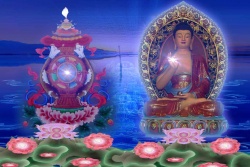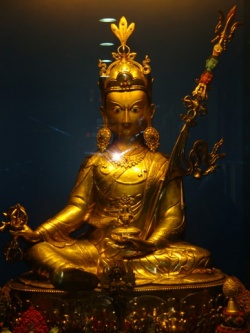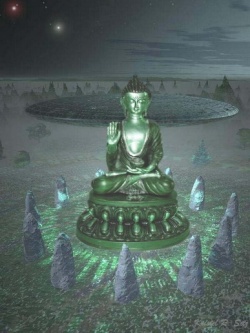Paramattha
- Why are the Five Aggregates regarded as "paramattha" (ultimate), instead of sunnatta alone being regarded as paramattha?
On page 25 of his comprehensive manual, Bhikkhu Bodhi lays out the difference between the conventional and the ultimate. He says that the conventional is a product of mental construction (parikappana) that does not exist by way of its own-existence (sabhava). As examples, he mentions living beings, persons, men, women, animals, and all the apparently stable persisting objects that make up the world. He says that all of these things, while appearing distinct, when seen through Abhidhammic analysis do not have any distinct existence because they are an assemblage of impermanent factors, of mental and physical processes.
By contrast, "ultimate" dhammas are the final, irreducible components of existence, not mentally constructed at all, and they are regarded as intrinsic and distinct.
My contention is that the Five Aggregates do not seem to fit the definition of an "ultimate" dhamma, only sunatta does, since only sunatta is irreducible and has a distinct nature. After all, if the Five Aggregates can be reduced to sunatta, they are not irreducible. If the Five Aggregates origin' involves creating concepts from sunnatta, then they are mental fabrications too, and thus, conventional.
He seems to acknowledge that there is no such thing as sabhava (own-existence) for conventional objects: people, animals, buildings, trees, etc.. No such "thing" can be said to exist distinctly for the obvious reason that it is dependently originated. But I see nothing that distinguishes the Five Aggregates from these types of things either.
Also, even assuming that matter, consciousness, and the mental factors are "ultimate" (basically meaning truly real), it's not clear to me why what is produced by them should be any less substantial. I believe there were some early Buddhist schools which actually held this substantialist view.
(Nyanaponika ABHIDHAMMA STUDIES @ page 41 BPS; page 42 Wisdom.)
By arranging the mental factors in relational groups a subordinate synthetical element has been introduced into the mainly analytical Dhammasangani.
By so doing, the danger inherent in purely analytical methods is avoided. This danger consists in erroneously taking for genuine separate entities the “parts” resulting from analysis, instead of restricting their use to sound practical method with the purpose of classifying and dissolving composite events wrongly conceived as unities.
Up to the present time it has been a regular occurrence in the history of physics, metaphysics, and psychology that when the “whole” has been successfully dissolved by analysis, the resultant “parts” themselves come in turn to be regarded as little “wholes.”
(Prof. Dr. Y. Karunadasa @ THE DHAMMA THEORY, page 9:)
In the Pali tradition it is only for the sake of definition and description that each dhamma is postulated as if it were a separate entity; but in reality it is by no means a solitary phenomenon having an existence of its own. . . . If this Abhidhammic view of existence, as seen from its doctrine of dhammas, cannot be interpreted as a radical pluralism, neither can it be interpreted as an out-and-out monism.
For what are called dhammas -- the component factors of the universe, both within us and outside us -- are not fractions of an absolute unity but a multiplicity of co-ordinate factors. They are not reducible to, nor do they emerge from, a single reality, the fundamental postulate of monistic metaphysics.
If they are to be interpreted as phenomena, this should be done with the proviso that they are phenomena with no corresponding noumena, no hidden underlying ground. For they are not manifestations of some mysterious metaphysical substratum, but processes taking place due to the interplay of a multitude of conditions. http://www.zeh-verlag.de/download/dhammatheory.pdf
(Harvey @ in his excellent INTRODUCTION TO BUDDHISM, characterizes the Theravadin position, page 87:)
"'They are dhammas because they uphold their own nature [sabhaava]. They are dhammas because they are upheld by conditions or they are upheld according to their own nature' (Asl.39). Here 'own-nature' would mean characteristic nature, which is not something inherent in a dhamma as a separate ultimate reality, but arise due to the supporting conditions both of other dhammas and previous occurrences of that dhamma."
(A.K. Warder @ in INDIAN BUDDHISM, page 323, discussing the Pali Abhidhamma commentarial literature, states:)
"The most significant new idea in the commentaries is the definition of a 'principle' or element (dharma): dharmas are what have (or 'hold', 'maintain', dhr. is the nearest equivalent in the language to the English 'have') their own own-nature (svabhaava). It is added that they naturally have this through conditions."
Paramattha: sacca-vacana-Desanā 'truth or term, exposition that is true in the highest or ultimate sense', as contrasted with the 'conventional truth' vohāra-sacca which is also called 'commonly accepted truth' sammuti-sacca in Skr: samvrti-satya
The Buddha, in explaining his doctrine, sometimes used conventional language and sometimes the philosophical mode of expression which is in accordance whith unconfused insight into reality.
In that ultimate sense, existence is a mere process of physical and mental phenomena within which, or beyond which, no real ego-entity nor any abiding substance can ever be found.
Thus, whenever the suttas speak of man, woman or person, or of the rebirth of a being, this must not be taken as being valid in the ultimate sense, but as a mere conventional mode of speech vohāra-vacana.
It is one of the main characteristics of the Abhidhamma Pitaka, in distinction from most of the Sutta Pitaka, that it does not employ conventional language, but deals only with ultimates, or realities in the highest sense paramattha-dhammā
But also in the Sutta Pitaka there are many expositions in terms of ultimate language paramattha-desanā namely, wherever these texts deal with the groups khandha elements dhātu or sense-sources āyatana and their components; and wherever the 3 characteristics tilakkhana are applied.
The majority of Sutta texts, however, use the conventional language, as appropriate in a practical or ethical context, because it;would not be right to say that 'the groups' khandha feel shame, etc
It should be noted, however, that also statements of the Buddha couched in conventional language, are called 'truth' vohāra-sacca being correct on their own level, which does not contradict the fact that such statements ultimately refer to impermanent and impersonal processes.
The two truths - ultimate and conventional - appear in that form only in the commentaries, but are implied in a sutta-distinction of 'explicit or direct meaning' nītattha and 'implicit meaning to be inferred' neyyattha Further, the Buddha repeatedly mentioned his reservations when using conventional speech, e.g. in D. 9:,These are merely names, expressions, turns of speech, designations in common use in the world, which the Perfect Qne Tathāgata uses without misapprehending them.; See also S. I. 25.
The term paramattha in the sense here used, occurs in the first para. of the Kathāvatthu, a work of the Abhidhamma Pitaka see: Guide, p. 62. App: vohāra.
The commentarial discussions on these truths Com. to D. 9 and M. 5 have not yet been translated in full. On these see K N. Jayatilleke, Early Buddhist Theory of Knowledge London, 1963, pp. 361ff.
In Mahāyana, the Mādhyamika school has given a prominent place to the teaching of the two truths.
"By arranging the mental factors in relational groups a subordinate synthetical element has been introduced into the mainly analytical Dhammasangani. By so doing, the danger inherent in purely analytical methods is avoided. This danger consists in erroneously taking for genuine separate entities the “parts” resulting from analysis, instead of restricting their use to sound practical method with the purpose of classifying and dissolving composite events wrongly conceived as unities. Up to the present time it has been a regular occurrence in the history of physics, metaphysics, and psychology that when the “whole” has been successfully dissolved by analysis, the resultant “parts” themselves come in turn to be regarded as little “wholes.”
The Venerable was in fact saying that the Abhidhamma's Dhammasangani analytic method was tempered by some recourse to the synthetic method (of the Patthana?). In so doing, the Dhammasangani avoided the metaphysical trap of atomism, ie simplistic reductionism leading to essences that are self-existent.




